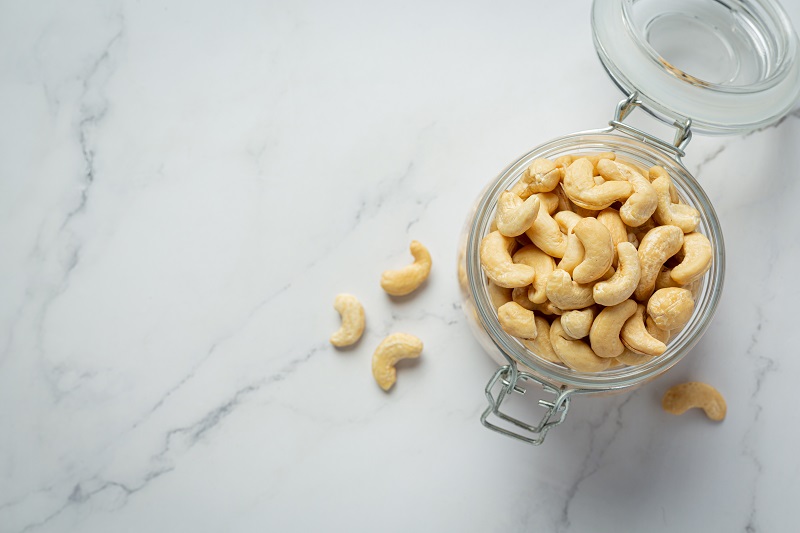We all have heard about the cashew and we all have some misconceptions related to it. People believe that cashew belongs to the nuts family but they are from the seeds of a tropical fruit called the cashew apple.
But do you know that cashew is used for a variety of purpose and are known as snack superstar? It is not just a simple snack but a nutritional powerhouse of goods fats, vitamins, and mineral bonanza, rich in fiber with a good source of protein.
The taste of cashews fills with a creamy bite and buttery aroma, and from farm to table, cashews have a fascinating journey. So, let’s find out the different types and grades unlocked with the cashew.
So, let’s begin this blog with different types of cashews and later on find out the grades of it. This blog will explore everything for you and keep you informed while choosing the right cashew.
Types of Cashews
Raw Cashews
These are the recently removed, unshelled cashew kernels from the cashew apple. Their flavor is mild and nutty, and they need to be processed or roasted before eating.

Roasted Cashews
These are the most popular kind, and roasting brings out their crunch and sweetness. Distinct flavor profiles are produced by various roasting techniques, such as oil roasting or dry roasting.

Salted Cashews
The natural sweetness of the cashews is enhanced and given a savory twist by a dash of salt. The degree of salinity varies according to preference and brand.

Flavored Cashews
When it comes to flavored cashews, the options are endless, ranging from sweet cinnamon sugar to fiery chili lime. These excite snacking and appeal to palates that are daring.

Cashew Butter
This creamy spread, which is made from ground cashews, is a great substitute for peanut butter because it has a concentrated nuttiness.

Grades of Cashews
While grading schemes vary slightly from place to place, cashews are generally categorized according to their size, color, and overall appearance. Let’s examine a few of the most typical grades:
White Wholes
● W180: The king of cashews, large and ivory-white, perfect for presentations and luxurious snacking.
● W210: Jumbo cashews, slightly smaller than W180, but still impressive in size and visual appeal.
● W240: A popular choice, offering good-sized kernels at a reasonable price. Ideal for snacking, salads, and cooking.
● W320: The most commercially available grade, with medium-sized kernels suitable for various culinary applications.
● W450: The smallest and most affordable whole cashews, perfect for budget-conscious consumers and bulk baking.
Scorched Wholes
The longer roasting or processing time of these cashews has resulted in a slightly darker hue. They are perfect for cooking and turning into cashew butter because they keep their flavor and nutritional value but have a less appealing appearance.
Dessert Wholes
This category, which frequently includes broken or chipped kernels, is categorized as “seconds” in terms of appearance. But they work great for giving candies, granola, and desserts some texture and crunch.
Pieces
Cashews that are broken or have strange shapes fall into this category. They are frequently less expensive and just as delicious and nourishing as whole cashews. They work well for roasting, cooking, and preparing cashew butter.
Beyond Grades
Grades provide a foundational understanding, but there are more considerations when selecting cashews. The place of origin is important: Indian cashews are typically more yellow-colored than Vietnamese cashews, which are distinguished by their ivory hue. Processing techniques like oil or vacuum roasting have an impact on texture and flavor as well.
Choosing the Right Cashew
Choosing the right cashews depends on your needs and preferences. It includes various factors and aspects while choosing the cashew like its purpose, budget, size and color, taste, and many more factors.
So, check out these factors in detail and make the right decision.
So, check out these factors in detail and make the right decision.
● Purpose: Are you snacking, baking, cooking, or making cashew butter?
● Budget: Higher grades generally command a higher price.
● Size and Color: Do you prefer large, impressive cashews or smaller, more economical options?
● Taste: Do you want a mild, nutty flavor or something more pungent and roasted?
So, while choosing the right cashew, you need to focus on the factors provided. Also, you need to check out the grades too. Make yourself informed while making the decision.
Closing Note
By understanding the different types and grades of cashews, you can make informed choices and truly appreciate the nuances of this versatile nut. So, the next time you reach for a handful of cashews, remember the journey they have taken, from tropical orchards to your pantry, and savor the unique flavor and quality each one offers.


